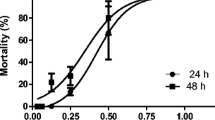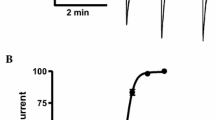Abstract
Essential plant oils (or their active principles) are safe to use and a potentially attractive alternative to current antiparasitic drugs. In the present study, we tested the effects of carvacrol on the isolated tissues of Ascaris suum and investigated potential interactions with other antiparasitic drugs. We used somatic muscle flaps for contraction assays, as well as for electrophysiological investigations. Carvacrol 300 μM highly significantly inhibited contractions caused by 1, 3, 10, 30, and 100 μM of ACh (p = 0.0023, p = 0.0002, p = 0.0002, p < 0.0001, and p < 0.0001). The control EC50 for acetylcholine was 8.87 μM (log EC50 = 0.95 ± 0.26), while R max was 2.53 ± 0.24 g. The EC50 of acetylcholine in the presence of 300 μM of carvacrol was 27.71 μM (log EC50 = 1.44 ± 0.28) and the R max decreased to 1.63 ± 0.32 g. Furthermore, carvacrol highly significant potentiates inhibitory effect of GABA and piperazine on the contractions induced by ACh. However, carvacrol (100 and 300 μM), did not produce any changes in the membrane potential or conductance of the A. suum muscle cell. While, 300 μM of carvacrol showed a significant inhibitory effect on ACh-induced depolarization response. The mean control depolarization was 13.58 ± 0.66 mV and decreased in presence of carvacrol to 4.50 ± 1.02 mV (p < 0.0001). Mean control Δg was 0.168 ± 0.017 μS, while in the presence of 300 μM of carvacrol, Δg significantly decreased to 0.060 ± 0.018 ΔS (p = 0.0017). The inhibitory effect on contractions may be the explanation of the antinematodal potential of carvacrol. Moreover, inhibition of depolarizations caused by ACh and reduction of conductance changes directly points to an interaction with the nAChR in A. suum.






Similar content being viewed by others
References
Abdel-Rahman FH, Alaniz NM, Saleh MA (2013) Nematocidal activity of terpenoids. J Environ Sci Health B 48(1):16–22
Anthony RM, Rutitzky LI, Urban JF, Stadecker MJ, Gause WC (2007) Protective immune mechanisms in helminth infection. Nat Rev Immunol 7:975–987
Barros LA, Yamanaka AR, Silva LE, Vanzeler MLA, Braum DT, Bonaldo J (2009) In vitro larvicidal activity of geraniol and citronellal against Contracaecum sp (Nematoda: Anisakidae). Braz J Med Biol Res 42:918–920
Brooker S (2010) Estimating the global distribution and disease burden of intestinal nematode infections: adding up the numbers? A review. Int J Parasitol 40:1145–1154
Camurça-Vasconcelos ALF, Bevilaqua CML, Morais SM, Maciel MV, Costa CTC, Macedo ITF, Oliveira LMB, Braga RR, Silva RA, Vieira LS (2007) Anthelmintic activity of Croton zehntneri and Lippia sisidoides essential oils. Vet Parasitol 148:288–294
Ellis MD, Baxendale FP (1997) Toxicity of seven monoterpenoids to tracheal mites (Acari: Tarsonemidae) and their honeybee (Hymenoptera: Apidae) hosts when applied as fumigants. J Econ Entomol 90:1087–1091
Enan EE (2005) Molecular response of Drosophila melanogaster tyramine receptor cascade to plant essential oils. Insect Biochem Mol Biol 35:309–321
Hierro I, Valero A, Pérez P, González P, Cabo MM, Montilla MP, Navarro MC (2004) Action of different monoterpenic compounds against Anisakis simplex s.l. L3 larvae. Phytomedicine 11(1):77–82
Holden-Dye L, Krogsgaard-Larsen P, Nielsen L, Walker RJ (1989) GABA receptors on the somatic muscle cells of the parasitic nematode, Ascaris suum: stereoselectivity indicates similarity to a GABAA-type agonist recognition site. Br J Pharmacol 98(3):841–850
Hugot JP, Baujard P, Morand S (2001) Biodiversity in helminths and nematodes as a field of study: an overview. Nematology 3:199–208
Kaplan RM, Storey BE, Vidyashankar AN, Bissinger BW, Mitchell SM, Howell SB, Mason ME, Lee MD, Pedroso AA, Akashe A, Skrypec DJ (2014) Antiparasitic efficacy of a novel plant based functional food using an Ascaris suum model in pigs. Acta Trop 139:15–22
Komuniecki R, Law WJ, Jex A, Geldhof P, Gray J, Bamber B, Gasser RB (2012) Monoaminergic signaling as a target for anthelmintic drug discovery: receptor conservation among the free-living and parasitic nematodes. Mol Biochem Parasitol 183(1):1–7
Lacey E (1990) Mode of action of benzimidazoles. Parasitol Today 6(4):112–115
Lei J, Leser M, Enan E (2010) Nematicidal activity of two monoterpenoids and SER-2 tyramine receptor of Caenorhabditis elegans. Biochem Pharmacol 79(7):1062–1071
Martin RJ (1982) Electrophysiological effects of piperazine and diethylcarbamazine on Ascaris suum somatic muscle. Br J Pharmacol 77(2):255–265
Martin RJ, Puttachary S, Buxton SK, Verma S, Robertson AP (2014) The Conqueror Worm: recent advances with cholinergic anthelmintics and techniques excite research for better therapeutic drugs. J Helminthol 29:1–11
Paterson S, Barber R (2007) Experimental evolution of parasite lifehistory traits in Strongyloides ratti (Nematoda). Proc Biol Sci 274:146–174
Payne L, Fitchett JR (2010) Bringing neglected tropical diseases into the spotlight. Trends Parasitol 26(9):421–423
Pirri JK, McPherson AD, Donnelly JL, Francis MM, Alkema MJ (2009) A tyramine-gated chloride channel coordinates distinct motor programs of a Caenorhabditis elegans escape response. Neuron 62(4):526–38
Richmond JE, Jorgensen EM (1999) One GABA and two acetylcholine receptors function at the C. elegans neuromuscular junction. Nat Neurosci 2(9):791–797
Tong F, Coats JR (2012) Quantitative structure-activity relationships of monoterpenoid binding activities to the housefly GABA receptor. Pest Manag Sci 68(8):1122–1129
Tong F, Gross AD, Dolan MC, Coats JR (2013) The phenolic monoterpenoid carvacrol inhibits the binding of nicotine to the housefly nicotinic acetylcholine receptor. Pest Manag Sci 69(7):775–780
Trailovic SM, Clark CL, Robertson AP, Martin RJ (2005) Brief application of AF2 produces long lasting potentiation of nAChR responses in Ascaris suum. Mol Biochem Parasitol 139(1):51–64
Acknowledgments
This study was supported by the Ministry of Education and Science Republic of Serbia, Grant No TR31087.
Author information
Authors and Affiliations
Corresponding author
Rights and permissions
About this article
Cite this article
Trailović, S.M., Marjanović, D.S., Nedeljković Trailović, J. et al. Interaction of carvacrol with the Ascaris suum nicotinic acetylcholine receptors and gamma-aminobutyric acid receptors, potential mechanism of antinematodal action. Parasitol Res 114, 3059–3068 (2015). https://doi.org/10.1007/s00436-015-4508-x
Received:
Accepted:
Published:
Issue Date:
DOI: https://doi.org/10.1007/s00436-015-4508-x




